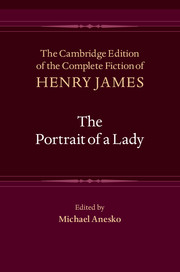Book contents
- Frontmatter
- Contents
- List of Illustrations
- Acknowledgments
- List of Abbreviations
- General Editors’ Preface
- General Chronology of James’s Life and Writings
- Introduction
- Textual Introduction
- Chronology of Composition and Production
- Bibliography
- The Portrait of a Lady
- Glossary of Foreign Words and Phrases
- Notes
- Textual Variants
- Emendations
- Appendices
Appendix A - Extracts from James’s Notebooks
Published online by Cambridge University Press: 11 April 2021
- Frontmatter
- Contents
- List of Illustrations
- Acknowledgments
- List of Abbreviations
- General Editors’ Preface
- General Chronology of James’s Life and Writings
- Introduction
- Textual Introduction
- Chronology of Composition and Production
- Bibliography
- The Portrait of a Lady
- Glossary of Foreign Words and Phrases
- Notes
- Textual Variants
- Emendations
- Appendices
Summary
Henry James’s Notebooks are collected in Volume XXXIV of The Complete Fiction of Henry James. The editor of that volume, Philip Horne, has excerpted and prepared the texts for this Appendix, and has supplied a few essential glosses and annotations; more extensive notes can be found in the volume devoted to The Notebooks.
The following passage is drawn from the first volume of James's notebooks in the Houghton Library, Harvard (MS Am 1094 (v. 1)). This volume of the notebooks runs from 7 November 1878 to 11 March 1888; the excerpt that follows probably dates from late December 1880 or early January 1881.
P. of an L.After Isabel’smarriage there are fivemore instalments, and the success of the whole story greatly depends upon this portion being well conducted or not. Let me then make the most of it—let me imagine the best. There has been a want of action in the earlier part, and it may be made up here. The elements that remain are, in themselves, I think, very interesting, and they only need to be strongly and happily combined. The weakness of the whole story is that it is too exclusively psychological—that it depends to[o] little on incident; but the complete unfolding of the situation that is established by Isabel's marriage may nonetheless be quite sufficiently dramatic. The idea of the whole thing is that the poor girl, who has dreamed of freedom and nobleness, who has done, as she believes, a generous, natural, clear-sighted thing, finds herself in reality ground in the very mill of the conventional. After a year or two of marriage the antagonism between her nature and Osmond's comes out—the open opposition of a noble character and a narrow one. There is a great deal to do here in a small compass; every word, therefore, must tell—every touch must count. If the last five parts of the story appear crowded, this will be rather a good defect in consideration of the perhaps too great diffuseness of the earlier portion. Isabel awakes from her sweet delusion—oh, the art required for making this delusion natural! and finds herself face to face with a husband who has ended by conceiving a hatred for her own larger qualities.
- Type
- Chapter
- Information
- The Portrait of a Lady , pp. 951 - 959Publisher: Cambridge University PressPrint publication year: 2016

